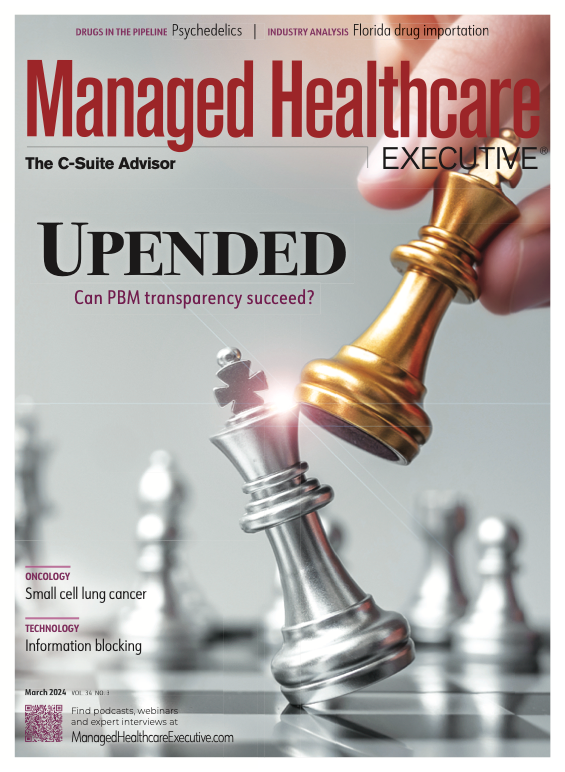Upended: Can PBM Transparency Succeed?
Simmering tensions in the pharmacy benefit management (PBM) industry have turned into fault lines. The PBMs challenging the "big three" have formed a trade association. Purchaser coalitions want change. The head of the industry's trade group says inherent marketplace friction has spilled over into political friction.
It wasn’t long ago that pharmacy benefit managers (PBMs) labored in relative obscurity in American healthcare. Hospitals, doctors, health insurance companies, pharmaceutical manufacturers — those were the industry’s stars, wielding not-minor amount of clout over policies set in Washington and in state capitals throughout the country.
PBM may not quite be a household initialism, but the industry has emerged from the shadows. Some of attention has been sought and positive. When the hepatitis C antivirals hit the market in the mid-2010s, the PBMs took credit for using their bargaining power to push back on what then seemed like astronomically high prices.
More recently, the attention has been more of the uninvited kind. The Columbus (Ohio) Dispatch published an investigative series in 2018 probing CVS Caremark and its spread pricing practices (the company said the newspaper had presented a “skewed view of reimbursement rates” and rejected appeals for balanced reporting). Other news outlets, trade publications and bloggers followed suit, casting the industry as a profit-grabbing middleman with opaque business practices — and worse. Congress swung into action last year with three bills introduced in the Senate that would increase oversight and regulation of the industry in a number of different ways. In December 2023, by a large bipartisan majority, the House passed a healthcare policy bill that included provisions that would ban spread pricing and impose disclosure requirements on PBMs.
These legislative moves occurred after the Federal Trade Commission (FTC) launched an investigation of the industry in 2022 and then, in 2023, withdrew previous guidances that were favorable to PBMs.
Meanwhile, simmering intraindustry tensions between the three largest PBMs — CVS Caremark, Optum Rx and Express Scripts — and the trade association they belong to, the Pharmaceutical Care Management Association (PCMA), and a cadre of smaller PBMs that bill themselves as transparent alternatives to the “big three,” as they are known in the industry, came to a head. Six of the smaller PBMs launched an alternative trade group, Transparency-Rx, in
September 2023.
Joseph Shields, J.D.

“They landed at this central premise that the drug pricing model is broken and there needs to be new and innovative solutions to fix it,” says Joseph Shields, J.D., Transparency-Rx’s managing director and a founder, who has years of experience lobbying on Capitol Hill.Collectively, the PBMs in his group manage pharmacy benefits for more than 15 million people, which, Shields notes,would make the group, if it were a single PBM, the fourth largest in the U.S.
Shields says he battles a preconception that the transparent PBMs in the new trade group are inexperienced companies, metaphorically or literally operating out of someone’s garage with only some seed funding to keep them going. Some of the companies in Transparency-Rx have been in business for decades, he says, and even the younger companies have gone through several rounds of funding and have several years of operating under their belts.
The embattled industry has responded. During an earnings call in February 2024, CVS Health CEO Karen Lynch touted the company’s previously announced CostVantage and TrueCost price transparency models, which will be offered in 2025, as breaks from the past; TrueCost, she said,will show “the true net cost of prescription drugs with continued client visibility into administrative fees.” Late last year, Express Scripts announced that it would start offering a ClearNetwork product this year that charges a “straight-forward estimated acquisition cost” for medications plus a dispensing and service cost fee.
PCMA, which has only 17 members despite the size of the industry it advocates for,has stepped up its lobbying and public relations efforts. An animated graphic on its website shows a figure representing PBMs pushing an arrow representing drug costs back against a figure representing “big pharma.”
J.C. Scott, J.D.

If he is fazed by the casting of the PBMs as the black hats of the drug industry and all the brickbats being hurled their way,J.C. Scott, J.D., the president and CEO of PCMA, didn’t show it in a recent interview with Managed Healthcare Executive. Affable and talkative, Scott says some conflict comes with the territory for PBMs because they are, on one side, negotiating with drugmakers to bring down drugs costs and, on the other, dealing with retail pharmacies to develop networks and incentivize higher quality care. “What’ve we seen is that this marketplace friction increasingly spills into political friction,” says Scott.
PBMs have become a target partly because other stakeholders in the drug industry are jumpy from being “squeezed,” in Scott’s view. For drugmakers, the pressure is from the Inflation Reduction Act and for retail pharmacies, it is competition from Amazon and supermarket retailers setting up their own in-store pharmacies.
“[Some] of what we’re seeing isn’t just friction in the market,” says Scott. “It’s also what’s happened around those stakeholders that is causing them to feel more anxious.”
How we got here
Managing pharmacy benefits wasn’t always a big deal in American healthcare. In the era of “take two aspirin and call me in the morning,” there weren’t that many medications, and they weren’t all that expensive. When managed care started to take offafter the passage of the Health Maintenance Organization Act of 1973 and the implementation of diagnostic-related group payment to hospitals in the 1980s, the focus was on medical services and moves to limit how long patients stayed in the hospital.
Three major trends pushed managing the cost and delivery of pharmaceuticals from the wings of U.S. healthcare and its politics to center stage. After headlines about shortened hospital stays and allegations that overbearing insurers were dictating medical care, providers, patients and policymakers pushed back against managed care. The consolidation of hospitals into large healthcare systems also worked to limit how far managed care could go with medical services. This is not to say that insurers have abandoned managing medical care; there are plenty of day-to-day conflicts and policy fights about prior authorization, provider networks and denial of claims. But the struggle is no longer open warfare and, politically, it is more the steady backbeat than the catchy hook.
The second trend is the growing prominence, in almost every way imaginable, of pharmaceuticals in American healthcare. What was once a relatively spare armamentarium now has shelves upon shelves, stacked with drugs, and with that massive growth has come more drug-related cost and delivery to manage.In 1986, Tagamet (cimetidine) was the first drug to have $1 billion in annual sales and achieve blockbuster status. Now there dozens of blockbuster drugs, and projections that the new crop of GLP-1 weight loss drugs, including Wegovy (semaglutide) and Zepbound (tirzepatide), will top $100 billion annual sales. The FDA approved the first statin, lovastatin, in 1987, ushering in an era of drugs for cholesterol management and cardiovascular disease prevention. Now almost 50 million Americans take a statin daily.The first disease-modifying agent for multiple sclerosis was approved in 1993. Now there are about a dozen choices. Cancer treatment turned a corner in 2001 when the FDA approved Gleevec (imatinib), opening up a floodgate of treatments, most of them expensive, that home in more precisely on cancerous cells. Later came treatments — with even heftier price tags — that trick patient immune systems into attacking cancer cells instead
of pathogens. In 2022, drug expenditures in the U.S. totaled $405.9 billion and accounted for approximately 9% of the $4.5 trillion that the country spent on healthcare, according to CMS actuaries. The annual growth in spending on prescription drugs was 8.4%, more than double the overall
growth of 4.1%.
The third trend is change to the structure of the PBM industry itself, which occurred partly in reaction to the soaring growth in the number and expense of the prescriptions they manage. T. Joseph Mattingly, Pharm.D., Ph.D., MBA, an associate professor at the University of Utah; David Hyman, M.D., J.D., a professor at Georgetown Law School; and Ge Bai, Ph.D., a professor at Johns Hopkins University, published an information-rich article in JAMA Health Forum in November 2023 that surveyed the history, business practices and economics of the PBM industry.They outlined the convoluted history of acquisitions and businesses shifting into pharmacy benefit management that resulted in the current concentration of the industry. CVS Caremark, Optum Rx and Express Scripts manage roughly 80% of U.S. prescriptions.
Jeff Casberg, RPh, M.S.

Jeff Casberg, RPh, M.S., vice president of clinical pharmacy at IPD Analytics and a member of the Managed Healthcare Executive editorial advisory board, notes that by virtue of electronically processing the vast majority of prescriptions in the U.S.,the big three are handling (and have access to) vast amounts of valuable data. “They connect the clinical and financial elements of each prescription, including the exact drug dispensed, the prescribing doctor, the amount paid to the pharmacy, the patient’s cost share, drug interactions and warnings, and who the pharmacy and insurance payer are.”Part of the reason for the rise of PBMs, says Casberg, is that pharmacy management has become such a large, complex and specialized business that health insurers can’t do it on their own.
In addition to becoming more concentrated, a web of deals has also situated those three large PBMs in massive, vertically integrated healthcare companies. CVS Health acquired Caremark in 2007 and then Aetna, the health insurer, in 2018. That same year, Cigna acquired Express Scripts, which had acquired Medco, a PBM, in 2012 after it was spun off by the drugmaker Merck. UnitedHealth Group acquired PacifiCare, a Medicare Advantage business that had a PBM, in 2005 and then, through a series of acquisitions and other moves, created the
present-day Optum Rx.
These giant healthcare companies are still commonly associated with their legacy businesses — CVS with the retail pharmacies emblazoned with its name and Cigna and UnitedHealth Group with its health insurance business. But the growing number of healthcare companies, including their PBMs, in their portfolios account for an increasing proportion of their revenues and profits. For example, in 2023, Optum Rx had revenues of
$116 billion, which accounted for approximately 30% of UnitedHealth Group’s revenues of $372 billion, according to
a recent earnings report
‘Broken market’
Much of the current controversy and criticism of the PBM industry can be traced back to concern (the feelings often run hotter than mere concern) about the dominance of the big three and their perch in even larger healthcare companies. The FTC inquiry is looking for evidence of anticompetitive consequences from the industry’s structure and related practices. PCMA’s Scott sees a broader political dynamic at play. There is this idea, he says, “from both far edges of the political spectrum that somehow big is bad in business and has to be broken up. To some extent we get pulled into that.”
Shawn Gremminger, M.P.P.

Shawn Gremminger, M.P.P., sees the situation entirely differently. Gremminger became the president and CEO of the National Alliance of Healthcare Purchaser Coalitions in January. His organization represents employers and unions that self insure for healthcare coverage. Gremminger is not a noncombatant when it comes to PBMs; prior to his current job he was a public affairs consultant and Transparency-Rx was one of his clients. He has a pithy, direct speaking style.
“I don’t think the people who run PBMs are bad. I don’t think they are intentionally trying to hose employers and consumers,” says Gremminger. “But I think they are in a broken market and have found that the way to make money is to engage in practices that I think are really difficult to defend on their face, and the people who get hurt, ultimately, are employers, purchasers and working families who are paying for these premiums and paying extremely high drug costs.”
Among the practices that Gremminger is referring to are the rebates that PBMs collect from drugmakers that are based on claims for their products. The amounts of those rebates and how much the PBM keeps and how much it passes along to employer and health plans, has been a closely held secret by the PBMs. The large PBMs have also come under fire for spread pricing — charging the payer more for a prescription than it pays a pharmacy and collecting the difference, or spread.
Gremminger says the reality of PBM transparency about pricing and charges falls far short of the major players’ assurances that they are forthcoming about prices and costs. “The big PBMs will suggest that ‘no, we’re not opaque at all, we’re absolutely transparent, we can be as transparent as you want us to be.’ I think the experience for employers and purchasers is that’s not really the case. The fact that the PBM industry is working so hard to defeat transparency requirements in Washington is a pretty strong indication that they don’t value transparency as part of their business model.”
Gremminger and other critics of the big PBMs point to the relatively recent creation of group purchasing organizations (GPOs) as exemplifying that the companies continue to keep their dealings hidden. In 2019, Express Scripts set up its GPO, Ascent Health Services. A year later, CVS Caremark launched Zinc and, in 2021, Optum Rx created Emisar Pharma Services.
“The GPOs are just sort of an add-on at thebottom or the top of the supply chain, depending on which way you want to look at it,” says Gremminger.
“One of the things we hear from the PBMs is that we’re full rebate passthrough,” he continues, where ‘everything we get, we pass on to you.’ Well, their full rebate passed through within the PBM. They’re not full rebate passthroughs through the GPO, which they own.” Gremminger says one of the provisions his business group wants to see in the PBM reform legislation under consideration in Congress is “end-to-end transparency” that would include the GPOs.
A ‘diverse, dynamic and competitive marketplace’
Scott is ready with answers to the criticisms of the PBMs, particularly the big three. It seems that little, if any, of this thrust and parry about PBMs and drug prices is new to him.
In a follow-up email after an interview conducted via Zoom, Scott said that GPOs help PBMs “obtain deeper price concessions from drug companies, which lowers the cost of drugs for employers and patients.”
During the interview, he defended spread pricing as a choice favored by smaller employers who want predictability and couched it as the PBM taking on downside and upside risk. Scott batted away the assertion that the rebates that PBMs collect from drug companies result in higher list prices: “Every piece of data that’s been analyzed would say that there’s no correlation between whether there is a rebate and where the list price is set.” Scott also said it is up to plan sponsors — employers and health plans — to decide how to use the rebates and other savings that his members deliver. In Medicare Part D, most of the money has gone toward keeping premiums down, he says, while in the commercial market the use has been more varied and has included lower out-of-pocket costs.
Scott also attempts to flip the script on the composition of the industry. Rather than big three dominance, Scott talks about a “very diverse, dynamic and competitive marketplace,” as evidenced by what he says is a 10% growth in the number of companies offering full PBM services during the past two years. Moreover, says Scott, there are companies “coming in on the edges” of the industry that are offering some elements of drug cost management; he mentions Mark Cuban Cost Plus Drug Company as an example. Cost Plus Drugs sells generic drugs at cost, plus a 15% markup and pharmacy fees.
It was big news in the PBM world last year when Blue Shield of California announced that it was dropping its exclusive arrangement with CVS Caremark and instead parceling out different aspects of its pharmacy benefits to Amazon Pharmacy; Mark Cuban Cost Plus Drug Company; Abarca, a PBM based in Puerto Rico; and Prime Therapeutics, a Minnesota-based PBM. The California Blues plan stuck with CVS Caremark for the management of the specialty drugs. Scott says what Blue Shield of California did is part of ahealthy trend, not a repudiation of PBMs: “In the PBM space, we see example after example of clients deciding that they want to exercise the power that they have to choose a different PBM and a different model.”
There are new entrants into the industry, acknowledges Gremminger. “The market is broken, but it suggests that it is not irreconcilably broken,” he says. But in Gremminger’s view, the question is how much market share can the PBMs competing with the big three realistically expect to gain. The smaller “disruptor PBMs,” as Gremminger calls them, are often in a position to offer management of generic drugs and a few mainline ones, but they may not have access to specialty drugs. “I think some of the employers look at this and say, ‘Well this is kind of a lot of work to get maybe marginal savings.’ ” Even if the benefit managers at employers are attracted to PBMs promisingtransparency and lower costs, Gremminger says risk-reward perceptions often lead to the status quo. “What’s the old line? ‘Nobody got fired for hiring IBM,’ ” he says. “If things go badly and you get complaints, you can say, ‘Well, look, I’m on contract with one of the three biggest PBMs in the country, you can’t fire me, I didn’t do anything wrong.’ But if you have the bravery to make a switch and say, ‘I am tired of this market, I am tired of getting played around with, I want to try something new,’ and then if things go poorly, you know that benefits manager’s head is on a plate.”
Even so, the smaller PBMs promising transparency are competing for business and having somesuccess. Earlier this year, it was heralded as a win for the smaller PBMs when Tyson Foods, a meat processing company with approximately 140,000 employees, dropped CVS Caremark in favor of Rightway. Meanwhile, Congress is considering a number of bills that might mean major changes in the way PBMs do business.
Next month: The politics of PBMs and the prospects for Congress passing legislation.

David Calabrese of OptumRx Talks New Role, Market Insulin Prices and Other Topics 'On His Mind'
April 13th 2023In this month’s episode of the "What's On Your Mind podcast," Peter Wehrwein, managing editor of MHE connects with the now Chief Clinical Officer of OptumRx Integrated Pharmacies, David Calabrese. In this conversation, David touches on his transition in January as OptumRx’s former chief pharmacy officer and market president of health plans and PBMs to his new role as Chief Clinical Officer where he now focuses more on things such as specialty pharmacy to home delivery — with an overall goal of creating whole-patient care. Throughout the conversation, Calabrese also touched on the market’s hot topic of insulin prices and behavioral health services within the OptumRx community, among other topics.
Listen
Briana Contreras, editor of Managed Healthcare Executive, spoke with Nancy Lurker, CEO and president of EyePoint Pharmaceuticals. Nancy shared a bit about EyePoint and how the organization’s innovative therapies are addressing patient needs through eye care, and most importantly, she addressed C-Suite positions like the CEO role. Nancy shared advice for those seeking to reach the CEO level, especially toward women in healthcare and other roles, and what it takes to run a biopharma company.
Listen